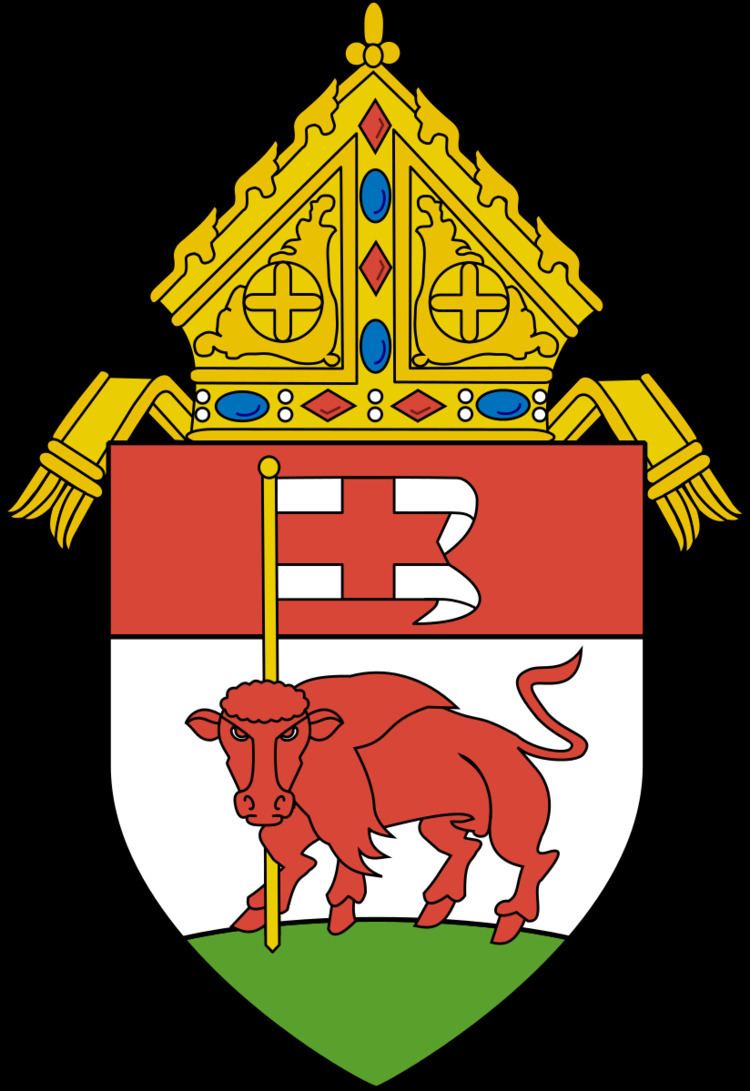Patron saint Saint Joseph | Phone +1 716-847-8700 | |
 | ||
Territory Western New York (Counties of Erie, Niagara, Genesee, Orleans, Chautauqua, Wyoming, Cattauraugus, and Allegany, New York) Metropolitan 795 Main StreetBuffalo, New York14203 Area 16,511 km (6,375 sq mi) Population- Total- Catholics (as of 2012)1,632,000721,000 (44.2%) Address 795 Main St, Buffalo, NY 14203, USA Profiles | ||
The Diocese of Buffalo is a Roman Catholic diocese headquartered in Buffalo, New York, United States. It is included in the province of the Roman Catholic Archdiocese of New York, in the Roman Rite. The Buffalo Diocese includes eight counties in Western New York State. The Catholic population is nearly 700,000. The Diocese is divided into more than 150 parishes, which also include churches, schools, convents, seminaries, hospitals, and colleges. The Buffalo Diocese was established in 1847. From the Buffalo Diocese, the Roman Catholic Diocese of Rochester was created in 1868. The Most Reverend Richard Joseph Malone became the 14th bishop of the Buffalo Diocese, August 10, 2012.
Contents
Range and population
The Diocese covers 6,455 square miles (16,720 km2) throughout the eight counties of Western New York; and has a Catholic population of 690,000. In the Diocese are 166 parishes, 15 high schools, 52 elementary schools, seven colleges and universities, one seminary, convents, and four hospitals.
Establishment
The Roman Catholic Diocese of Buffalo was established April 23, 1847. It was set apart from the great Diocese of New York and the See located at Buffalo on Lake Erie, the territory comprising nearly one-third of the State of New York.
Redistricting
In 1868, the Diocese of Rochester was formed from the eastern counties of the territory of the Diocese of Buffalo. In 1896, after Bishop Stephen Vincent Ryan's death, four more counties, including Steuben, Schuyler, Chemung, and Tioga, were taken from the Diocese of Buffalo and added to the Rochester jurisdiction.
Territories
The Diocese of Buffalo includes the following eight counties in Western New York State:
Bishops
The lists of bishops and auxiliary bishops of the diocese and their years of service, followed by other priests of this diocese who became bishops:
Bishops of the diocese
- John Timon, C.M. † (1847 - 1867); Died
- Stephen Michael Vincent Ryan, C.M. † (1868 - 1896); Died
- James Edward Quigley † (1896 - 1903); Appointed Archbishop of Chicago
- Charles Henry Colton † (1903 - 1915); Died
- Dennis Joseph Dougherty † (1915 - 1918); Appointed Archbishop of Philadelphia
- William Turner † (1919 - 1936); Died
- John Aloysius Duffy † (1937 - 1944); Died
- John Francis O'Hara, C.S.C. † (1945 - 1951); Appointed Archbishop of Philadelphia
- Joseph Aloysius Burke † (1952 - 1962); Died
- James Aloysius McNulty † (1963 - 1972); Died
- Edward Dennis Head † (1973 - 1995); Retired
- Henry Joseph Mansell (1995 - 2003); Appointed Archbishop of Hartford
- Edward Urban Kmiec (2004 - 2012); Retired
- Richard Joseph Malone (2012–Present)
Auxiliary bishops
Seminaries
Convents
School restructuring
In 2005, Bishop Edward Kmiec announced that the Diocese would begin a school restructuring effort as part of the "Journey of Faith and Grace Campaign." In 2007, 14 Catholic elementary schools in the Diocese closed. The closures, alphabetically by city, included Most Precious Blood, Angola; Genesee-Wyoming Catholic, Attica; St. Agnes, St. Bernard, and St. Rose of Lima, Buffalo; Infant of Prague, St. Josaphat, Kolbe Catholic, Resurrection, and St. Aloysius Gonzaga, Cheektowaga; St. Barnabas, Depew; St. Hyacinth, Dunkirk; Blessed Sacrament, Kenmore; and St. Edmund, Tonawanda. The school closures caused job losses to 158 full-time and 49 part-time employees. More than 1,410 students were negatively affected by the school closures in 2007, and were required to enroll in other educational programs outside of these schools. In the five years immediately preceding the school closures, many families had already begun removing their children from Catholic schools in the diocese due to the instability of the schools, and concerns about not desiring their children to be enrolled in schools in which there was little or no future.
Regarding the 14 school closures in 2007, Bishop Kmiec stated in a February 2007 article written by Mark Ciemcioch in the Western New York Catholic:
This restructuring is necessary to respond to changing demographics, population and economic realities in Western New York;...this is the most difficult decision I've ever made [while] being a bishop for 24 years.While the average cost of teaching one student in the 14 schools in 2007 was $4,738, the average tuition cost for the student was $1,525. Therefore, the debt of those schools' parishes averaged $224,160, and totaled more than $3.3 million altogether. Secretary of the Department of Catholic Education Denise McKenzie stated that the deficit can, therefore, lead to a significant deficit in the schools and associated parishes even prior to the beginning of each school year. The Diocese of Buffalo contributed millions of dollars to support schools whose parishes used up monies to subsidize their schools. In early 2007 alone, the Diocese was operating with a $2.1 million deficit, in part, due to the subsidies provided to schools and parishes.
Cheektowaga, the area hardest-hit by the school closures with five schools lost in 2007, experienced great demographic changes in recent years. The area was once heavily Catholic, though the majority of the population of older adults has been replaced by those who are younger and non-Catholic. Younger couples have moved to the area, purchasing starter homes, and have moved out of the area when they begin having children, causing in decline in enrollments in the city's Catholic schools, particularly in kindergarten classes. The dramatic change has resulted in drastically reduced enrollments, for example in the Infant of Prague School in 1960 that had 1,120 students, and had only 117 enrolled students in 2007. St. Barnabas School in Depew – one of the schools that closed in 2007 – had only 57 students enrolled that year, making it less than minimally viable per Msgr. John Madsen.
